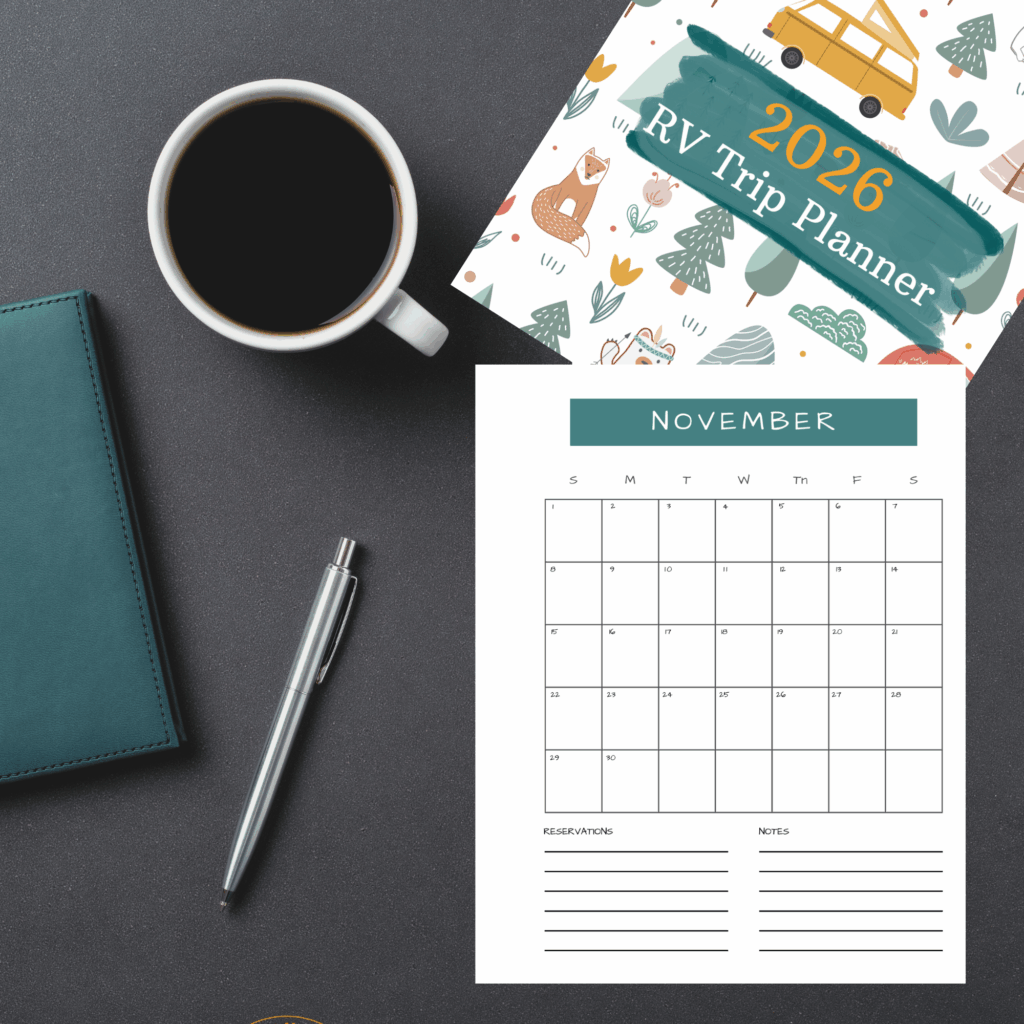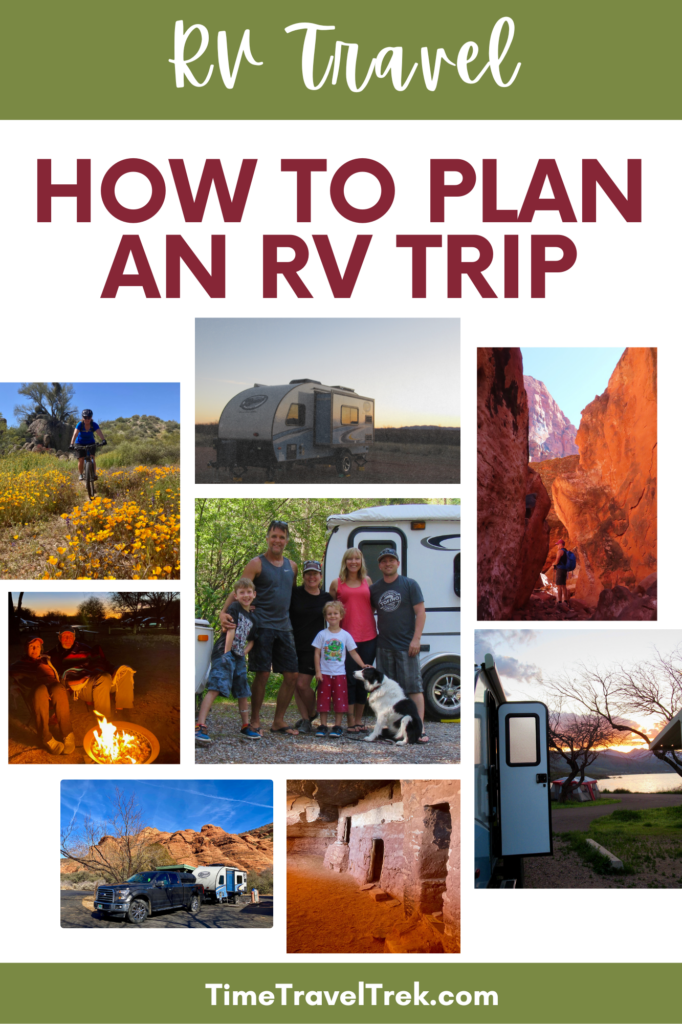Learning how to plan an RV trip in the U.S. or Canada is about more than just picking a destination—it’s about crafting an adventure that balances flexibility with smart preparation.
Whether you’re drawn to the towering red rock canyons and open deserts of the American Southwest or the rugged coastline of Canada’s Atlantic Provinces, having a basic plan in place will make your journey more enjoyable.
From mapping out your route to securing must-have campsite reservations, this step-by-step guide will help you turn your RV travel dreams into reality.
Disclosure: This post contains affiliate links. If you buy something from one of our affiliates, we receive a small commission at no extra charge to you. Thanks for helping to keep our blog up and running!
Table of Contents
How to Plan an RV Trip
Whether you’re planning your first of 50th RV trip in Canada or the States, the process – from picking your travel dates to gathering relevant info to booking your campsites – is the same.
With a few key steps, you can avoid the stress of last-minute scrambling and focus on what really matters—exploring new cultural sites and new hiking and biking trail adventures. Okay, maybe that’s just me, but the point is don’t waste your trip time! Grab a planner and let’s get started.
1. Know Your Travel Dates
Obviously, these can be flexible, but having a general time frame will give you a solid starting point to outline your trip.
Use a calendar and outline your dates, noting weekends and holidays when campsites and tours and attractions may be busier.
2. Decide Where You Want to Go
No sense researching the Grand Canyon or Sedona if your focus is Southern Arizona. Likewise, skip looking at the Atlantic Provinces if you’re heading to Western Canada. Narrow down your region first!
Tip: Pick up a travel guidebook from your local library for the general area you’re considering (e.g., The American Southwest). Flip through and make a list of places that catch your interest.
A good map of the area is also a great tool, like this one for The Maritime Provinces of Canada.
3. Plan Ahead for National & State or Provincial Park Stays
If you want to camp in National Parks or State/Provincial Parks, book in advance! Many fill up months ahead, especially in peak seasons.
- U.S. National Parks: Reservations are made through Recreation.gov. Most national park sites allow booking six months in advance, but some, like Yosemite, have different advance booking windows (ranging from five months to one week). Mark these dates down early.
- Canadian National Parks: Reservations open in January for the upcoming year, but dates vary. Check the Parks Canada reservation page for specific launch dates.
- State/Provincial Parks: These also have varying reservation timelines, so check early and write down key dates.

4. Gather Travel & Camping Info
Most states and provinces offer free online visitor guides, like Travel Alberta or Visit California. Many also have printed versions available. If you’re a member of CAA, AAA, or similar motor clubs, stop by their office for maps and guides.
5. Plan Your Driving Distance & Timeline
Grab a blank page in your planner and fill in these blanks:
- Total trip distance: _________________________
- Miles/km per day you want to drive: _________________________
- Total days available (including stops): _________________________
Now, do the math! Divide total miles/km by your daily driving limit.
Does it fit within your total trip time? If not, adjust your expectations or modify your route.
6. Map Out Your Route
Use Google Maps, MapQuest, or other route planners to create a general itinerary. Do you have enough time to explore everything? Do you need to trim it down? Be realistic.
7. Planning an RV Trip Involves Finding & Listing Campsites
Make a list of potential overnight spots, including:
- National & State/Provincial Park campgrounds
- Regional & municipal campgrounds
- Private RV parks
- BLM campgrounds
Check out blogposts focused on where to camp while RVing in Canada or the U.S..
8. Start Booking Your Campsites
When reserving sites, have details on hand:
- RV length & slide-outs (which side if applicable)
- Power requirements (20, 30, or 50-amp)
- Need for sewer hookups or dump stations

Write down reservation confirmation numbers and add them to a travel planner—or use our 2026 RV trip planner to stay organized.
Tip: If a campground is fully booked, check for single-night openings at different sites within the same park—sometimes breaking up a stay gets you in. We did this for a trip to Dead Horse Ranch State Park and eventually managed to get the whole time we wanted.
9. Stay Flexible with Booking
If you’re open to spontaneity, not every site needs to be reserved. Calling a day or two ahead often secures a mid-week spot, but weekends book fast. Have a backup list of alternatives in case your first choice is full.
10. Consider Free Camping Options
If campsites are full or you want to save money, check out free camping options where allowed, including:
- rest stops & visitor centers
- chain stores like Walmart or Canadian Tire (always call ahead to confirm overnight parking is allowed)
- find more free camping on websites and apps like Freecampsites.net, iOverlander, Campendium

11. Research Activities for Each Stop
Once your route and campsites are set, start compiling fun activities for each area using your collected resources—maps, books, online travel guides, and blogs. Make a list of must-see sights, hikes, historic sites, and outdoor adventures.
12. Hit the Road & Enjoy Your RV Adventure
Get out there – but don’t stop. When you’re finally out on the road, this is the time to fine tune your adventures.
When you arrive at a campsite, check pamphlet racks or visitor centers for local travel gems—like hiking trails, wildlife spots, and historic sites—that might not show up in online searches. We’d never have discovered Nevada’s Mt. Irish Archaeological Site if we hadn’t read about it in a free newspaper picked up during our travels.
Ready to Make Your Next RV Adventure Stress-Free?
Planning your next RV trip doesn’t have to be a headache—in fact, it should be part of the adventure! With the right prep—picking your route, snagging the best campsites, and mapping out epic stops—you’ll set yourself up for an unforgettable journey. Imagine rolling into your dream destination stress-free, knowing exactly where you’re staying and what amazing hikes, historic sites, or paddling spots await.
How to Plan an RV Trip Checklist
- Know your travel dates
- Decide where you want to go
- Plan ahead for national and state or provincial park stays
- Gather travel and camping info
- Plan your driving time and distance
- Map out your route
- Find and list potential campsites
- Book campsites
- Stay flexible with dates and reservations
- Consider free camping (boondocking) options
- Research activities for each stop
- Hit the road and enjoy the journey!
To keep trip your organized and full of fun adventures, be sure grab one of our RV travel printables—like the checklist of Cultural Sites in Arizona or the travel itinerary for Northwest Mounted Police Barracks or the RV Travel Pet Care Planner—from our Etsy shop. These travel tools amp enjoyment and reduce stress so you can focus on the fun.
What are you waiting for? Start planning today and make this RV trip your best one yet!


Leave a Reply